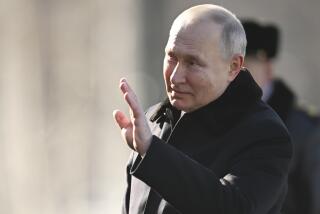Inspection Breakthrough
- Share via
The Soviet decision to open some of its civilian nuclear power reactors to international inspection is welcome and potentially valuable, however questionable the Kremlin’s motives may be.
The Nuclear Non-Proliferation Treaty requires all signatory nations that do not possess nuclear weapons to forswear their acquisition or development and to open their nuclear plants to inspection by the International Atomic Energy Agency to determine that no nuclear material is being diverted into A-bombs.
The treaty does not require the nuclear powers to permit such inspections. As a symbolic gesture, however, the United States and Britain allow representatives of the International Atomic Energy Agency to inspect their civilian nuclear plants, though not the facilities engaged in military work. So does France, which has not signed the treaty.
Until now the Soviet Union has not allowed international inspectors to look at any of its nuclear plants, whether civilian or military. However, Moscow signed an agreement with the IAEA last February allowing such inspections, and the international agency said this week that its inspectors will be allowed access to an unspecified number of civilian Soviet reactors--said to be two--sometime this month.
The tardy and limited Soviet concession is hardly spectacular. As in the American case, the inspections will have no impact on military nuclear programs. And the Reagan Administration is probably right when it predicts that the Soviet reactors that are opened to inspection will be of the least sensitive types.
The Soviets are obviously playing to the galleries. Representatives of the more than 120 nations that signed the 1970 treaty to halt the spread of nuclear weapons will meet in Geneva Aug. 27 to review the workings of the pact. As happened at the last review conference in 1980, Third World nations are expected to complain about inadequate access to nuclear supplies and technology--and to condemn the major powers for not living up to their pledges, embodied in the treaty, to make significant reductions in their nuclear arsenals.
Moscow is making strenuous efforts to be viewed in a more favorable light than the United States. Step one was Soviet leader Mikhail S. Gorbachev’s recent declaration of a five-month moratorium on nuclear testing. Now comes step two, the opening of a couple of nuclear plants to international inspection just before the meeting begins.
The Soviet move, though cynical, is nonetheless welcome. The question of on-site inspection has bedeviled U.S.-Soviet negotiations on a comprehensive test ban as well as the outlawing of chemical and biological weapons. Although it has shown some flexibility in the test-ban negotiations, the Soviet Union has historically objected to on-site inspections as a needless invasion of its sovereignty.
Any move to allow outside experts to poke around in Soviet facilities is a positive step because, by setting a precedent, it could make it easier for Soviet negotiators to accept inspection in other areas of arms control. At best, however, that threatens to be a long and difficult process.
More to Read
Sign up for Essential California
The most important California stories and recommendations in your inbox every morning.
You may occasionally receive promotional content from the Los Angeles Times.












